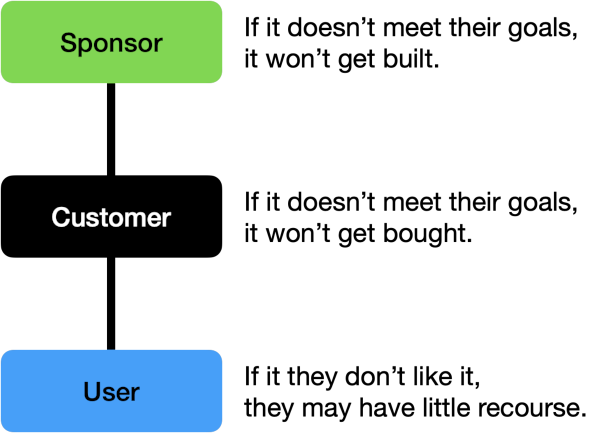It’s easy to throw around terms like Customer and User, but what do they mean? They’re actually complex concepts, and our goal for stories is sometimes not for the user’s direct benefit.
Customers are a subset of Stakeholders, or the Project Community, since they certainly affect and are affected by the product.
Customer Types
I like the model of customer types that Steve Blank and Bob Dorf describe in The Startup Owner’s Manual. [See References.]
[End] Users: The people who interact with the software.
Influencers: People who influence the buyer. They’re often external, and include people like trend-setters.
Recommenders: People with “make-or-break” opinions.
Economic Buyer: Those who control or approve the purchase. Their authority is granted by the Ultimate Decision Maker (if it’s not them).
[Ultimate] Decision Makers: Those who have ultimate authority to buy or not. They may override their designated Economic Buyer.
-and-
Saboteurs: Those who may derail the purchase process.
With this model, the same person may be in multiple roles e.g., both a buyer and a user.
In Pictures
Individual Customer – B2C
In the B2C (“Business to Consumer”) space, these roles basically fold together. For example, I’m an amateur musician. I need a tuner app for my phone. I am the user, economic buyer, and ultimate decision maker. I may be influenced by product reviews, others’ experiences, etc. My teacher and musician friends are recommenders, and I don’t expect a saboteur.
BigCo Customer – B2B
Things are different when you’re selling to a big company. The user, economic buyer, and decision maker are usually separate. There may even be layers of them. The users may have some influence, and may or may not be in the recommender role.
Influencers include people at conferences, trade publications, online reviews, etc. Trusted outsiders may be recommenders, e.g., Gartner Group.
There may be external or internal saboteurs. For example, there may be someone on the recommender team who prefers a different system. Or perhaps the Ops group hates the proposed app; since they’ll be managing the trial, they’re certainly in a position to put their thumbs on the scale.
You can see why the full model exists when you consider the challenges that companies have in selling to other companies.
Small Business Customer – B2B
A small business has intermediate complexity. The buyer is often the owner, and thus also the decision maker. Typically they’re a user (at least at the managerial or monitoring level); they may or may not have other users.
The Agency Problem
Whenever you have separate people or groups involved, especially ones spending other people’s money, you have agency problems [see References]: who’s acting as a proper agent for whom?
That is, there are incentives for people to maximize their own benefit rather than, say the company they work for. Did someone choose the system because it was the best choice, or because spending $5M more makes them look more important?
Who Benefits?
For all we talk about user stories, the user is often enough not the beneficiary of a story. The “Other” Golden Rule applies: who has the gold, makes the rules.
First off, stories are chosen for the benefit of the sponsor paying for the development. You’ve probably noticed this when you’ve been the purchaser online – “How would you like to pay?” never includes the option “with a penny”.
After the sponsor has been considered, the next level is often “to drive sales” (so you get features that seem more for review comparison checklists than for users), or it’s “to make money for the purchasing company”. For example, I’ve heard executives ask for software to monitor employees, but never heard employees ask for it.
This isn’t to say there are never stories for the benefit of a user; many are. But especially in the B2B case, not all stories are. It’s understandable that businesses need a sustainable business model “or else”. But there are too many stories that harm someone for me not to mention the possibility.
It’s not just B2B stories that have this problem; many apps have hidden costs that users would reject if they knew about them. I had a Sudoku app that turned my phone into a hand warmer (mining bitcoin?), and there are many well-documented cases of secret and involuntary user privacy violations.
I don’t want this to take away from the stories that are there to benefit the user, or support them in doing something they want to do in a context such as being employed. Just recognize that if knowledge is power, so is embedded knowledge.
Conclusion
It’s easy to use the words “Customer” or “User”, but especially in business-to-business sales, these are complex concepts. We briefly looked at a model from Steve Blank and Bob Dorf with several specializations: User, Economic Buyer, Ultimate Decision Maker, Recommender, Influencer, and Saboteur.
Buyers and users are not usually the same, and this brings up the question “who benefits?” It’s not always the user.
References
“Agency Problem“, by Investopedia.
The Startup Owner’s Manual, by Steve Blank and Bob Dorf.
“Start Here: User Stories“, by Bill Wake

